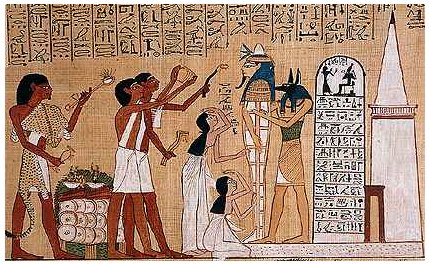2. Wikipedia: "Despite its faintness, Capricornus has one of the oldest mythological associations, having been consistently represented as a hybrid of a goat and a fish since the Middle Bronze Age. First attested in depictions on a cylinder-seal from around the 21st century BC, it was explicitly recorded in the Babylonian star catalogues as MUL-SUHUR.MA 'The Goat-Fish' before 1000 BC. The constellation was a symbol of the god Ea and in the Early Bronze Age marked the winter solstice. Due to the precession of the equinoxes the December solstice no longer takes place while the sun is in the constellation Capricornus, as it did until 130 BCE, but the astrological sign called Capricorn begins with the solstice. The solstice now takes place when the Sun is in Sagittarius. The sun's most southerly position, which is attained at the northern hemisphere's winter solstice, is now called the Tropic of Capricorn, a term which also applies to the line on the Earth at which the sun is directly overhead at noon on that solstice. The Sun is now in Capricorn from late January through mid-February. In Greek mythology, the constellation is sometimes identified as Amalthea, the goat that suckled the infant Zeus after his mother Rhea saved him from being devoured by his father Cronos (in Greek mythology). The goat's broken horn was transformed into the cornucopia or horn of plenty. Capricornus is also sometimes identified as Pan, the god with a goat's head, who saved himself from the monster Typhon by giving himself a fish's tail and diving into a river. The planet Neptune was discovered in Capricornus by German astronomer Johann Galle, near Deneb Algedi (δ Capricorni) on September 23, 1846, which is appropriate as Capricornus can be seen best from Europe at 4:00 am in September." The name Neptune certainly must have originated from the idea of a 'Sea' in the night sky. The star Deneb Algiedi ought to have risen heliacally around February 13 in 1846, and whether by coincidence or not 409 (February 13) - 266 (September 23) = 143 (= 365 - 222):
Perhaps the G calendar covers both astronomical facts (e.g. the solstices in 'June and 'December) and astrological remnants (e.g. ancient dates in 'May and 'November):
The Pleiades rose heliacally at equinox around (136 - 80) * 72 = 4032 years ago (as compared to my assumed year 1870 for the G text), and ca 7 * 72 = 500 years earlier the stars at equinox were the twin Hyades, etc:
The time of equinox for the pair of Goat Kids (Haedus I and II) was around 3500 B.C. At the time of G (or rather 2 * 72 = 144 years earlier) the Tejat twins marked the June solstice - but of course they would have marked equinox around (172 - 80) * 72 = 6624 years earlier. At this early age Canopus could have been regarded as responsible for making the summer year return:
'June 21 is day 172 counted from the beginning of the Gregorian year (and 100 less than the day number for 'September 29). 172 - 86 = 86. The possible numerical relations are without bounds. 172 + 86 = 258, a number which might be read as a pointer to the beginning of Al Baldaah at 'January 29:
The Chinese Yue means Battle-axe says Allen. Possibly the Easter Island month Toki was beginning here (in day π counted from equinox). When Balder has been killed by an arrow an older tool was needed to make life return: ... 'By striking the anvil,' said Ogotemmêli, 'they get back from the earth some of the life-force they gave it. Their blows recover it.' ... (See at Toki.) "The adze is shown in ancient Egypt from the Old Kingdom onward. Originally the adze blades were made of stone, but already in the Predynastic Period copper adzes had all but replaced those made of flint. While stone blades were fastened to the wooden handle by tying, metal blades had sockets into which the handle was fitted ... A depiction of an adze was also used as a hieroglyph, representing the consonants stp, 'chosen', and used as: ...Pharaoh XX, chosen of God/Goddess YY... The ahnetjer (Manuel de Codage transliteration: aH-nTr) depicted as an adze-like instrument, was used in the Opening of the Mouth ceremony, intended to convey power over their senses to statues and mummies. It was apparently the foreleg of a freshly sacrificed bull or cow with which the mouth was touched ... The ritual involved the symbolic animation of a statue or mummy by magically opening its mouth so that it could breathe and speak. There is evidence of this ritual from the Old Kingdom to the Roman Period. Special tools were used to perform the ceremony, such as a ritual adze, an arm shaped ritual censer, a spooned blade known as a peseshkaf, a serpent-head blade, and a variety of other amulets. A calf's leg was also held up to the lips painted on the coffin.
The ancient Egyptians believed that in order for a person's soul to survive in the afterlife it would need to have food and water. A special ritual called the 'Opening of the Mouth' was performed so that the person who died could eat and drink again in the afterlife." (Wikipedia) | |||||||||||||||||||||||||||||||||||||||||||||||||||||||||||||||||||||||||||||||||||||||||||||||||||||||||||||||||||||||||||||||||||||||||||||||||||||||||||||||||||||||||||||||||||||||||||||||||||||||















